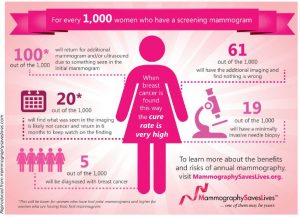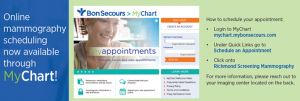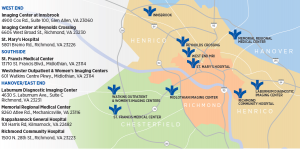Start at 40!
by Mark Dixon, MD, Fellowship-Trained Breast Imager
Christian Shield, MS, MD/MHA, Fellowship-Trained Breast Imager
Directors of Breast Imaging, Bon Secours Richmond Health System, Commonwealth Radiology Associates
Annual screening mammography—beginning at age 40 and continuing yearly—delivers the greatest benefit to the most women.
Thankfully, there has been dramatic progress in the treatment of breast cancer over the past several decades. In fact, the mortality from breast cancer since 1975 has decreased approximately 35%. A woman’s lifetime risk of breast cancer is approximately 12%—one in eight. As one might expect, this risk varies by age. Approximately 20% of breast cancer is diagnosed in women 40–50 years of age.
Recently, controversy has been generated about when to begin screening mammograms. Some would argue that screening should start after 45–50 years of age and be performed less frequently. The interdisciplinary breast specialists at Bon Secours believe in optimizing the benefits of screening for breast cancer. Waiting until 50 years of age to begin mammography would miss the opportunity to diagnosis and treat 20% of breast cancer. Screening more frequently than 24 months reduces mortality. Therefore, we continue to support yearly screening mammograms starting at age 40. We are not unique in our viewpoint. The American College of Radiology and Society of Breast Imaging continue to recommend screening at 40 years of age, as do leading cancer centers across the country, such as Memorial Sloan Kettering and MD Anderson.
The justification for the changes in screening mammography guidelines is not based on any scientific evidence. In fact, studies continue to show the benefits of screening mammography. The justifications for later and less frequent screening were based upon “efficiency” and over emphasized “harm” of screening and “overdiagnosis.”
Efficiency is simply the desire to minimize cost and maximize return on investment; it does not seek to maximize benefit. This is an economic decision that strives to minimize the cost to the system without consideration of the benefits to the individual.
Screening “harm” is the anxiety created when a woman is asked to return for additional images. In fact, only about 10% of women are asked to return, and the majority of these women are given reassurance that nothing is wrong. We feel the perceived “harm” from anxiety is overstated as compared to the very real harm of not detecting cancer. Additionally, cancers detected at a later stage may result in the need for more aggressive and extensive treatments, which can carry real consequences.
“Overdiagnosis” is simply the concept that some pre-invasive cancers, so-called Ductal Carcinoma in Situ or DCIS, may never evolve to be life-threatening. Unfortunately, we do not yet have the knowledge to predict which DCIS will harm the patient and which will not, so all DCIS is treated the same. We should always seek a cancer diagnosis where possible. Hopefully, in time, we will learn which cancers require treatment and which can be followed with surveillance.
We have dedicated our lives to detecting and fighting breast cancer. We feel passionately about women’s breast health and trust we have given you a good understanding of why you should begin getting yearly mammograms at age 40. Simply said: mammograms save lives. Start at 40!
Call 804‑627‑5660 to schedule your mammography appointment today!
Or, as part of your MyChart experience, you are now able to schedule your mammography appointment online at mychart.mybonsecours.com.




Comments are closed